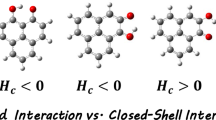Abstract
This work examined the local topological parameters of charge density at the hydrogen bond (H-bond) critical points of a set of substituted formamide cyclic dimers and enolic tautomers. The analysis was performed not only on the total electron density of the hydrogen bonded complexes but also on the intermediate electron density differences derived from the Morokuma energy decomposition scheme. Through the connection between these intermediate electron density differences and the corresponding differences in topological parameters, the meaning of topological parameters variation due to hydrogen bonding (H-bonding) becomes evident. Thus, for example, we show in a plausible way that the potential energy density differences at the H-bond critical point properly describe the electrostatics of H-bonding, and local kinetic energy density differences account for the localization/delocalization degree of the electrons at that point. The results also support the idea that the total electronic energy density differences at the H-bond critical point describe the strength of the interaction rather than its covalent character as is commonly considered.








Similar content being viewed by others
References
Pauling L (1960) The nature of the chemical bond. Cornell University Press, Ithaca
Grabowski SJ (2011) What is the covalency of hydrogen bonding? Chem Rev 111(4):2597–2625. doi:10.1021/cr800346f
Morokuma K (1977) Why do molecules interact? The origin of electron donor-acceptor complexes, hydrogen bonding and proton affinity. Acc Chem Res 10(8):294–300. doi:10.1021/ar50116a004
Morokuma K, Kitaura K (1981) Energy decomposition analysis of molecular interactions. In: Politzer P, Truhlar DG (eds) Chemical applications of atomic and molecular electronic potentials. Plenum, New York, pp 215–242
Clark T (2013) σ-holes. WIRES Comput Mol Sci 3(1):13–20. doi:10.1002/wcms.1113
Politzer P, Riley KE, Bulat FA, Murray JS (2012) Perspectives on halogen bonding and other σ-hole interactions: Lex parsimoniae (Occam’s Razor). Comput Theor Chem 998:2–8. doi:10.1016/j.comptc.2012.06.007
Angelina EL, Duarte DJR, Peruchena NM (2013) Is the decrease of the total electron energy density a covalence indicator in hydrogen and halogen bonds? J Mol Model 19(5):2097–2106. doi:10.1007/s00894-012-1674-y
Bader RWF (1990) Atoms in molecules: a quantum theory. Oxford University Press, New York
Angelina EL, Peruchena NM (2011) Strength and nature of hydrogen bonding interactions in mono- and di-hydrated formamide complexes. J Phys Chem A 115(18):4701–4710. doi:10.1021/jp1105168
Jenkins S, Morrison I (2000) The chemical character of the intermolecular bonds of seven phases of ice as revealed by ab initio calculation of electron densities. Chem Phys Lett 317(1–2):97–102. doi:10.1016/S0009-2614(99)01306-8
Arnold WD, Oldfield E (2000) The chemical nature of hydrogen bonding in proteins via NMR: J-couplings, chemical shifts, and AIM theory. J Am Chem Soc 122(51):12835–12841. doi:10.1021/ja0025705
Espinosa E, Alkorta I, Elguero J, Molins E (2002) From weak to strong interactions: a comprehensive analysis of the topological and energetic properties of the electron density distribution involving X–H···F–Y systems. J Chem Phys 117(12):5529–5542. doi:10.1063/1.1501133
Pakiari AH, Eskandari K (2006) The chemical nature of very strong hydrogen bonds in some categories of compounds. J Mol Struct THEOCHEM 759(1–3):51–60. doi:10.1016/j.theochem.2005.10.040
Grabowski SJ, Sokalski WA, Dyguda E, Leszczyński J (2006) Quantitative classification of covalent and noncovalent H-bonds. J Phys Chem B 110(13):6444–6446. doi:10.1021/jp0600817
Esrafili M (2012) Characteristics and nature of the intermolecular interactions in boron-bonded complexes with carbene as electron donor: an ab initio, SAPT and QTAIM study. J Mol Model 18(5):2003–2011. doi:10.1007/s00894-011-1221-2
Grabowski SJ, Sokalski WA, Leszczynski J (2006) The possible covalent nature of N-H⋯O hydrogen bonds in formamide dimer and related systems: an ab initio study. J Phys Chem A 110(14):4772–4779. doi:10.1021/jp055613i
Grabowski S (2009) Covalent character of hydrogen bonds enhanced by π-electron delocalization. Croat Chem Acta 82(1):185–192
Frisch MJ, Trucks GW, Schlegel HB, Scuseria GE, Robb MA, Cheeseman JR, Montgomery JA Jr., Vreven T, Kudin KN, Burant JC, Millam JM, Iyengar SS, Tomasi J, Barone V, Mennucci B, Cossi M, Scalmani G, Rega N, Petersson GA, Nakatsuji H, Hada M, Ehara M, Toyota K, Fukuda R, Hasegawa J, Ishida M, Nakajima T, Honda Y, Kitao O, Nakai H, Klene M, Li X, Knox JE, Hratchian HP, Cross JB, Adamo C, Jaramillo J, Gomperts R, Stratmann RE, Yazyev O, Austin AJ, Cammi R, Pomelli C, Ochterski JW, Ayala PY, Morokuma K, Voth GA, Salvador P, Dannenberg JJ, Zakrzewski G, Dapprich S, Daniels AD, Strain MC, Farkas O, Malick DK, Rabuck AD, Raghavachari K, Foresman JB, Ortiz JV, Cui Q, Baboul AG, Clifford S, Cioslowski J, Stefanov BB, Liu G, Liashenko GA, Piskorz P, Komaromi I, Martin RL, Fox DJ, Keith T, Al-Laham MA, Peng CY, Nanayakkara A, Challacombe M, Gill PMW, Johnson B, Chen W, Wong MW, Gonzalez C, Pople JA (2004) Gaussian 03, revision D01; Gaussian, Inc, Wallingford
Schmidt MW, Baldridge KK, Boatz JA, Elbert ST, Gordon MS, Jensen JH, Koseki S, Matsunaga N, Nguyen KA, Su S, Windus TL, Dupuis M, Montgomery JA (1993) General atomic and molecular electronic structure system. J Comput Chem 14(11):1347–1363. doi:10.1002/jcc.540141112
Keith TA (2012) AIMAll (Version 12.11.09). TK Gristmill Software, Overland Park, KS (http://aim.tkgristmill.com/)
Feynman RP, Leighton RB, Sands M (1964) The Feynman lectures on physics. Addison-Wesley, Reading
Bader RFW (1998) A bond path: a universal indicator of bonded interactions. J Phys Chem A 102(37):7314–7323. doi:10.1021/jp981794v
Bader RFW, Henneker WH, Cade PE (1967) Molecular charge distributions and chemical binding. J Chem Phys 46(9):3341–3363
Bader RFW, Preston HJT (1969) The kinetic energy of molecular charge distributions and molecular stability. Int J Quantum Chem 3(3):327–347. doi:10.1002/qua.560030308
Acknowledgment
We acknowledge the Secretaría de Ciencia y Tecnología de la Universidad Nacional del Nordeste (SECYT UNNE) and Consejo Nacional de InvestigacionesCientíficas y Técnicas (CONICET) for financial support. The authors also acknowledge the use of CPUs from the High Performance Computing Center of the Northeastern of Argentina (CECONEA). This work was supported by the Grants PIP 095 CONICET and 2010F023 SECYT-UNNE.
Author information
Authors and Affiliations
Corresponding author
Electronic supplementary material
Below is the link to the electronic supplementary material.
ESM 1
(DOCX 18 kb)
Rights and permissions
About this article
Cite this article
Duarte, D.J.R., Angelina, E.L. & Peruchena, N.M. Physical meaning of the QTAIM topological parameters in hydrogen bonding. J Mol Model 20, 2510 (2014). https://doi.org/10.1007/s00894-014-2510-3
Received:
Accepted:
Published:
DOI: https://doi.org/10.1007/s00894-014-2510-3




